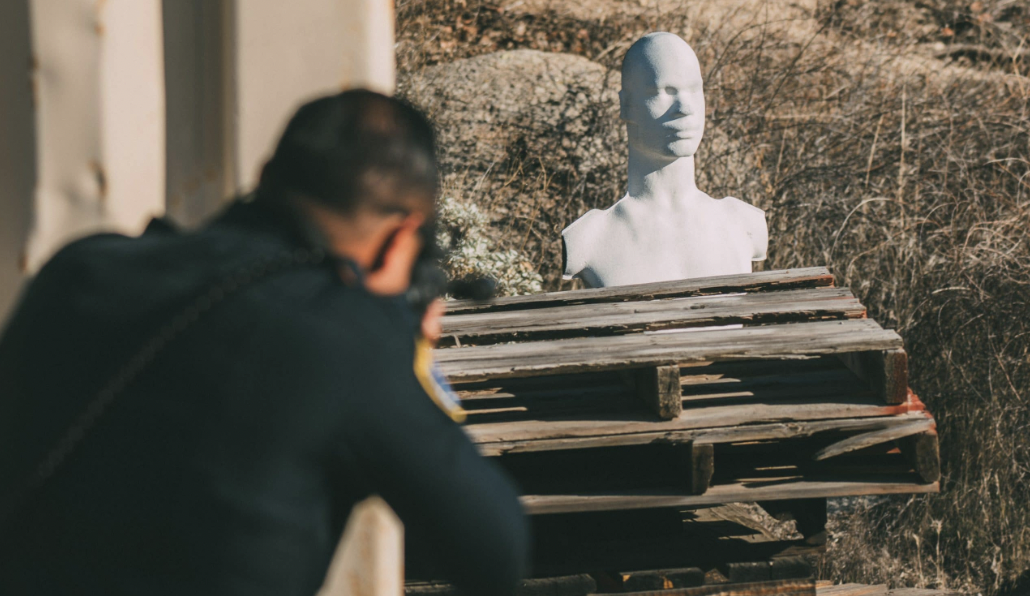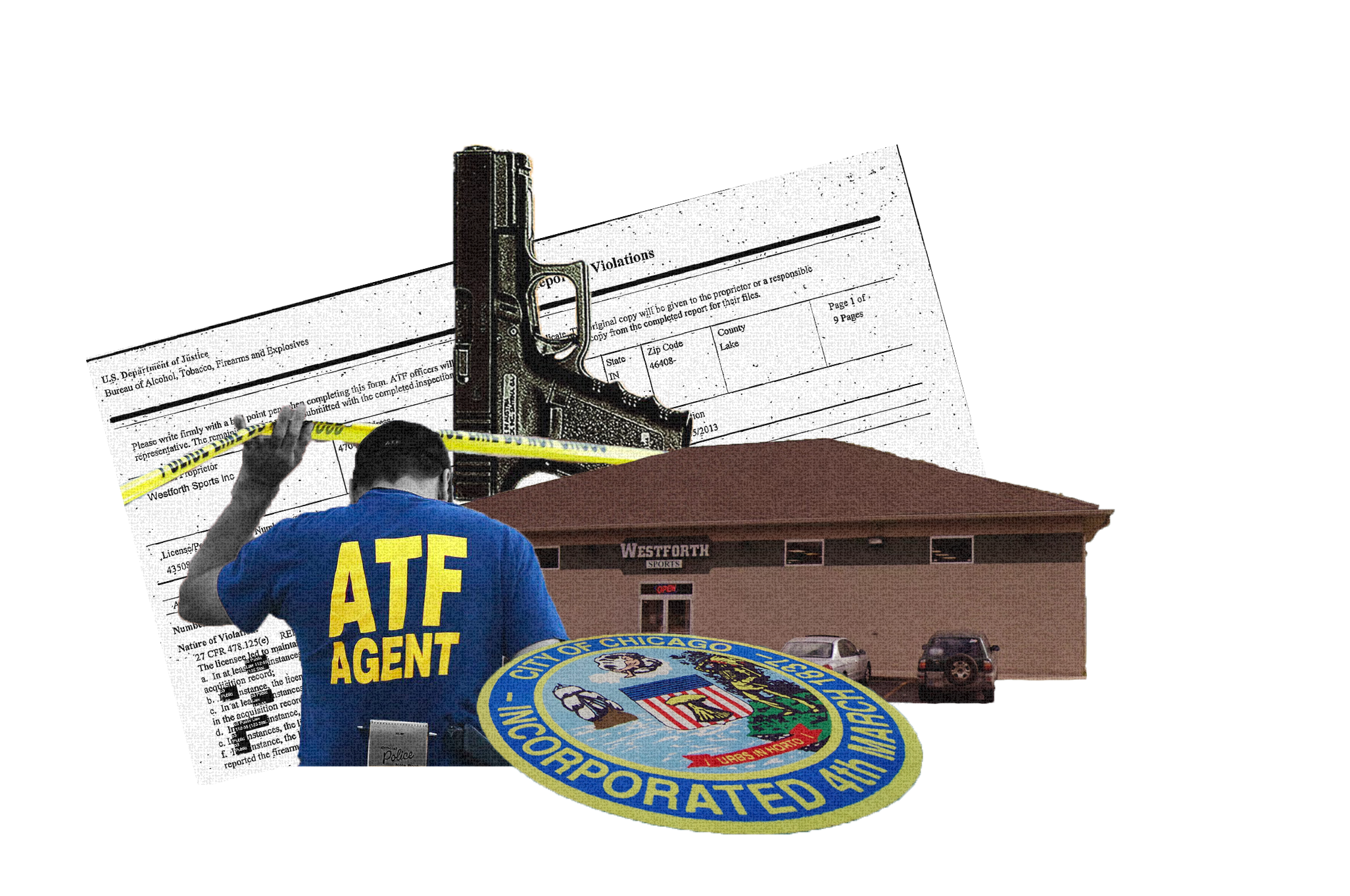UPDATE: On April 29, a spokesperson from the General Services Administration said that the dummy will be removed from the GSA schedule at the end of May.
The same day that the Grand Rapids Police Department released body-cam footage of an officer shooting Patrick Lyoya, a Black man, in the back of the head, a California artist launched an installation on state violence and the dehumanization of Black life. The focus was a rubber shooting target offered by the U.S. government to federal agencies.
“It’s just standing there, being Black. No arms so it can’t fight, no legs so it can’t run,” said Tracy Brown, who for her installation in Oakland added feathered wings to the rubber bust, binary elements of the African system of divination, and the names of people killed by police.
Last January, post-Ahmaud Arbery, post-George Floyd, post-election and insurrection, Brown began researching firearms training programs in the Bay Area. Like thousands of other Black Americans, particularly women, she wanted to learn how to use a gun. “I saw all of those domestic terrorists storm the U.S. Capitol,” she said. “It was not just that they did it, but that they did it without punishment. They went home and slept in their beds.”
As she searched the internet for classes and training groups, she came across the website for the Rubber Dummie shooting target, which looked like a Black man. The product is manufactured by Kistabra Inc., founded in 2013 by Mike Lessnick, a machinist and gun enthusiast who designed the lifelike rubber torso and head, painted white for the shooter to see their hits. Its face reminded Brown of her godson’s friend. “I totally saw myself in that figure,” she recalled.

“Do Black people come with all different shapes and sizes and skin? Absolutely,” Brown said. “But there are features of Africanity, phenotypic features that are shared.”
In 2019, Kistabra was awarded a General Services Administration (GSA) certification as a “armament training device,” meaning it sells its rubber Black man to U.S. government agencies in bulk and at substantial discounts. Kistabra secured a federal contract through 2024 worth up to $500,000.
In other words, taxpayers are placing this shooting target in front of law enforcement agencies. Those we contacted would not confirm buying them, and the GSA did not confirm which agencies it supplied them to. But according to the Rubber Dummies website, the target is being used by hundreds of law enforcement agencies nationwide, and every branch of the U.S. military.
Discovering the federal contract spurred Brown to action. She started working on the exhibition in downtown Oakland, then recently hosted a public panel to discuss the targets, and launched an online petition urging the GSA to cancel its contract with Kistabra.
When reached for comment, a GSA spokesperson said they were aware of Brown’s petition and that the agency was “committed to reviewing this matter thoroughly,” and “committed to advancing racial equity.”
“When I first saw [the target], it made me sick to my stomach,” said Mikhail Ali, deputy chief of the San Francisco Police Department, who was a guest speaker on Brown’s April 14 panel. “It made me sick because I immediately recognized it for what it is: a tool that I believe desensitizes those who use them in the area of use of force, as it relates to Black people.”
He is particularly outraged by the accessories sold by Rubber Dummie Inc., including “kill shot” packets of red dust that can be placed in an opening at the back of the figure’s skull and heart, and an apparel patch featuring the dummies with shots to the head and chest. It reads, “I’m always hanging around with a bunch of dummies.”
Black people are more than twice as likely to be killed by police than white people in the U.S., despite making up less than 13 percent of the population, according to data collected by The Washington Post. Last year, according to Mapping Police Violence, 266 Black people were killed by police out of 1,141 victims of all races. That’s 16 more than in 2020, when George Floyd was strangled to death in the street by an officer, Derek Chauvin.
“Looking at the state of affairs for Black people in America, and how we’re not protected,” said Brown, was why she wanted to train to protect herself with a firearm. “Even the people who are supposed to protect us don’t necessarily protect us.”
Once a proponent of buy-backs and stricter gun regulations, Brown’s relationship with firearms is now more complicated, she said. “Feeling like my life is in danger is something I’ve lived with since I was a kid, whether it was the police or community violence. But the difference now is I feel more empowered to do something about it.”
She has that in common with Lessnick, the target’s designer, who said “defensive training” was the impetus for his creation. He looked for a suitable device for two years, but couldn’t find a company that molded material into a lifelike shape. Eleven years ago, he said, he started a machine shop and started manufacturing his own target, with the help of a friend who agreed not to charge him for materials until he saw a profit.

Lessnick said he designed the rubber target, which can withstand between 5,000 and 7,000 rounds, to “to train defensively,” and provide a type of realism that paper and steel targets don’t allow. “I wish there was more high-value training, and the people who had firearms were required to get it. We have a right to carry them – I don’t deny that – but I’ll be honest that the six inches from the forehead to the ear makes a difference. That’s what training is about,” he said.
Lessnick did not respond to questions about whether he intended his target to portray a Black person.
Ali, the 30-year law enforcement officer on the panel, acknowledged the importance of realistic training, but said there is “zero need” for a shooting target to have racial or ethnic characteristics — or any human characteristics whatsoever.
“We don’t want to develop a mindset in our peace officers of killing,” Ali said. “We need to create a mindset of stopping the threat. Some people will say I’m wordsmithing, and I don’t think that’s the case. We want to create guardians of the community.”
On the Rubber Dummie website, defunct tabs for “law enforcement” and “military” appear designed for a law-and-order audience, but gun-rights enthusiasts, doomsday preppers, and popular YouTube product reviewers with tens of thousands of followers —“free marketing,” Lessnick called it — launched his product to a “large Pro2A” audience. The website attributes the target’s popularity to that movement, and “growing concerns over our personal safety.”
In one YouTube video, the reviewer is a white man who begins by enthusiastically referring to the dummy as an object, but over the next few minutes — as he shoots it from close and long range — reverts to calling the figure “him,” or “opponent,” or “adversary.” Another reviewer, Sootch00, remarks on the Rubber Dummies’ efficacy in “self defense” target practice.
“It gives you that shape, that silhouette for you to train the way you need to train,” he says in the video, ending on the slogan: “God bless America, long live the Republic.”
This rhetoric carries the threat of real civil violence, rooted in historic precedent, said Dr. Tony Jackson, the president of the Bay Area chapter of the Association of Black Psychologists and a speaker at Brown’s panel discussion on the target. Jackson said that the power of the image on the historically racist and violent American psyche cannot be underestimated. “Since the time we were brought here in chains, there has been systematic process for turning the African into what they call the Negro,” he said, “or from a human being into an animal.”
“This image of a shooting target comes in a long line of imagery for the purpose of desensitization to murder and mutilation of Black men, you see, so that’s the problem with whoever is shooting at this image,” regardless of ancestry.
“I see it as an escalation and a training tool,” Jackson added, “to desensitize a potential white racial militia to shooting Black folk, unarmed or armed.”
Models of the human form are easily found in online catalogs, for industrial or digital use. A quick internet search is how Lessnick found his Rubber Dummie, he said. Some are more egregiously categorized than others. “Head African Male,” for example, is a digital rendering with a broad nose and pronounced brow and lip. The simply titled “Man with Internal Organs” and “Man” are generic by comparison, and presumably white. Some female models have bright red nipples and lipstick. “Man Body International,” which most closely resembles Lessnick’s target, is a full-form, three-dimensional standing man with arms and legs, and facial characteristics of people of the African diaspora.
“Yep, that’s a good one right there,” Lessnick said to himself when he chose the model he would manufacture. In 2018, he was confronted at a firearms trade show by a Black Second Amendment enthusiast about the figure’s characteristics. Lessnick appeased the man, and said it was not “my intent nor even the thought process in my mind that it looked that way until somebody pointed it out to me.”
Once it was, he doubled down, and has continued manufacturing the original model. “Black people shoot at them all day every day,” his daughter recently told ABC News, calling the concerns “ridiculous.”
Brown said that lack of acknowledgement misses the “opportunity to evaluate how we approach dismantling these problems that we’ve created, identifying these things that feed into unhealthy imagery.”
That imagery may be precisely the figure’s appeal to private citizens who use it. But for law enforcement officers to be shooting at these figures on the taxpayer’s dime is a much more egregious oversight, said Ali. “Those that use it are being conditioned to see African Americans as threats. And if you, in law enforcement in particular, are conditioned to believe that African Americans are a threat, you’re more likely to believe they are criminals and that will increase the level of engagement that is not the same engagement with everyone else, and that is problematic,” he said. “It’s an injustice, also to those providing services, to be trained into a default and this kind of training tool does that.”
For Brown, who looks to the news and history to gauge her personal safety, government provisioning of this product is not surprising, but needs immediate correction.
“Black people are literally being hunted,” she said, and that is a reality the white men shooting at this target cannot equate with their experience. “My perspective is based on reality, on actuality, not some racist marketing of an idea of a threat. It’s based on watching the unequal treatment and weight of taking Black life.”

